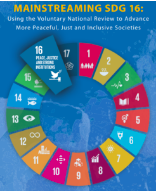One of the first steps for SDG16+ implementation is to integrate the targets into national and sub-national development plans, policies, strategies and budgets
Mainstreaming SDG16+ into national and sub-national development plans is one of the first steps to translating the global aspirations of SDG16+ into concrete action. “Mainstreaming” means incorporating or integrating the SDG16+ targets into national, sub-national and local plans, policies and strategies for development, and subsequently into budget allocations.1
While many countries have already mainstreamed the SDGs – including SDG 16 – into their planning documents and sustainable development policies,2 others may be just starting out. In some cases, countries may not have prioritized the implementation of SDG16+ targets during the first five years of SDG implementation due to competing pressing priorities. In other cases, countries may not have adequately incorporated the SDG16+ agenda into all relevant development plans and processes, given the depth and breadth of the SDG16+ targets.
Regardless of the situation, it is important that all countries review how existing national, sub-national and local development plans and sectoral strategies – in content and ambition – align with the SDG16+ agenda for peaceful, just and inclusive societies.3 Taking stock of how the SDG16+ targets are reflected in development strategies and planning processes is essential in order to identify areas that may need to be adapted for successful implementation. This process can also help to enhance policy coherence and integration among sectoral and other national, sub-national and local strategies that address peace, justice and/or inclusion. 4

While governments are responsible for mainstreaming SDG16+ into existing development plans and processes, civil society and other stakeholders can and should assist government actors in undertaking this process. Since 2016, the UN has been playing a central role in helping countries to integrate the SDGs into their national development processes through its “MAPS” (Mainstreaming, Acceleration and Policy Support) approach.
The following stages of the mainstreaming process – from the UN’s “Mainstreaming the 2030 Agenda for Sustainable Development – Reference Guide for UN Country Teams”5 – are summarized below, along with recommended actions for civil society actors:

TIP: Identifying and engaging with government officials
TIP: Mainstreaming guidance for countries in complex situations9

Countries in complex situations are often inundated with overlapping humanitarian, peacebuilding and development needs. Mainstreaming the SDGs in such contexts should consider and balance the tensions among:
Mainstreaming SDG 16: Using the Voluntary National Review to Advance More Peaceful, Just and Inclusive societies (Global Alliance and TAP Network, 2020)
This resource provides policy guidance, case studies and good practices on advancing SDG 16 implementation at national and subnational levels by more effectively leveraging the Voluntary National Review (VNR) and post-VNR processes. Available at: https://www.sdg16hub.org/topic/mainstreaming-sdg-16-using-voluntary-national-review-advance-more-peaceful-just-and-inclusive

This tool supports countries in mainstreaming the SDGs into national and subnational planning, by helping assess their readiness for SDG implementation. The tool suggests clear steps and templates for policy makers to conduct a rapid integrated assessment (RIA) of the SDGs to determine their relevance to the country context, both at the national and subnational level, and interlinkages across targets.
Available at: https://www.undp.org/content/undp/en/home/librarypage/sustainable-development-goals/rapid-integrated-assessment—mainstreaming-sdgs-into-national-a.html
This guide assists UN country teams in helping Member States adapt the global SDGs to national contexts. It presents a comprehensive set of eight practice areas for mainstreaming the 2030 Agenda along with a special section for countries in complex situations. Specific implementation steps, practical tools, and case examples from developed and developing countries are also provided. Available in English, Spanish and French.
Available at: https://unsdg.un.org/resources/mainstreaming-2030-agenda-sustainable-development-reference-guide-un-country-teams
Transparency, Accountability &
Participation (TAP) Network
Address: 205 E 42nd St.
New York, NY 10017
Email:
[email protected]